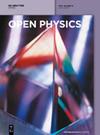Chaotic control problem of BEC system based on Hartree–Fock mean field theory
IF 1.8
4区 物理与天体物理
Q2 PHYSICS, MULTIDISCIPLINARY
引用次数: 0
Abstract
Due to the difficulty of studying nonlinear quantum systems and the unique composition of Bose–Einstein condensate (BEC) systems, BECs face significant difficulties in solving dynamic analysis and chaotic control problems. Therefore, Hartree–Fock mean field theory is introduced to study the chaotic characteristics, control, and synchronization issues of BEC systems loaded on optical lattices. First, the stability and chaos of BECs in optical lattices were analyzed. Subsequently, constant shift method and activation control were introduced based on the Gross–Pitaevskii equation to achieve control and synchronization of the BEC system. Second, based on the Lyapunov exponent theory, offset parameters are added to BEC chaotic control to achieve control of particle density. Finally, based on the stability theory of linear systems, a control term is introduced to achieve variable analysis of the system’s drive–response system, ensuring that chaotic systems with different initial conditions can still achieve good synchronization and anti-synchronization control. The chaotic problem of BEC system was analyzed using numerical and theoretical methods in the experiment. The effect of adjusting the parameters of the BEC system under the constant shift method is significant. The system exhibits a chaotic state under the Lyapunov exponent, which is mainly concentrated between [3.4, 4.5], demonstrating good system stability. When the offset constant range is [4.21, 5.67], the maximum Lyapunov exponent value is below 0. In the problem of chaotic synchronization, adding activation control causes the system’s time series to exhibit anti-synchronization with spatiotemporal variable variation, while adding control terms leads the system to tend towards synchronization and anti-synchronization with time evolution. The analysis of chaotic control problems in BEC systems can provide reference value and theoretical basis for the dynamic research of quantum physics and related nonlinear systems.基于哈特里-福克均值场理论的 BEC 系统混沌控制问题
由于研究非线性量子系统的难度和玻色-爱因斯坦凝聚态(BEC)系统的独特组成,BEC 在解决动态分析和混沌控制问题时面临很大困难。因此,本文引入哈特里-福克均场理论来研究加载在光学晶格上的 BEC 系统的混沌特性、控制和同步问题。首先,分析了光晶格中 BEC 的稳定性和混沌性。随后,基于 Gross-Pitaevskii 方程引入了恒定位移法和激活控制,以实现对 BEC 系统的控制和同步。其次,基于李雅普诺夫指数理论,在 BEC 混沌控制中加入偏移参数,实现对粒子密度的控制。最后,基于线性系统稳定性理论,引入控制项,实现系统驱动-响应系统的变量分析,确保不同初始条件下的混沌系统仍能实现良好的同步和反同步控制。实验中采用数值和理论方法分析了 BEC 系统的混沌问题。在恒定位移法下,调整 BEC 系统参数的效果显著。系统在 Lyapunov 指数下呈现混沌状态,主要集中在 [3.4, 4.5] 之间,表现出良好的系统稳定性。当偏移常数范围为[4.21,5.67]时,最大 Lyapunov 指数值低于 0。在混沌同步问题中,加入激活控制会使系统的时间序列随时空变量变化呈现反同步,而加入控制项则会使系统随时间演化趋于同步和反同步。对 BEC 系统混沌控制问题的分析,可为量子物理及相关非线性系统的动力学研究提供参考价值和理论依据。
本文章由计算机程序翻译,如有差异,请以英文原文为准。
求助全文
约1分钟内获得全文
求助全文
来源期刊

Open Physics
PHYSICS, MULTIDISCIPLINARY-
CiteScore
3.20
自引率
5.30%
发文量
82
审稿时长
18 weeks
期刊介绍:
Open Physics is a peer-reviewed, open access, electronic journal devoted to the publication of fundamental research results in all fields of physics. The journal provides the readers with free, instant, and permanent access to all content worldwide; and the authors with extensive promotion of published articles, long-time preservation, language-correction services, no space constraints and immediate publication. Our standard policy requires each paper to be reviewed by at least two Referees and the peer-review process is single-blind.
 求助内容:
求助内容: 应助结果提醒方式:
应助结果提醒方式:


